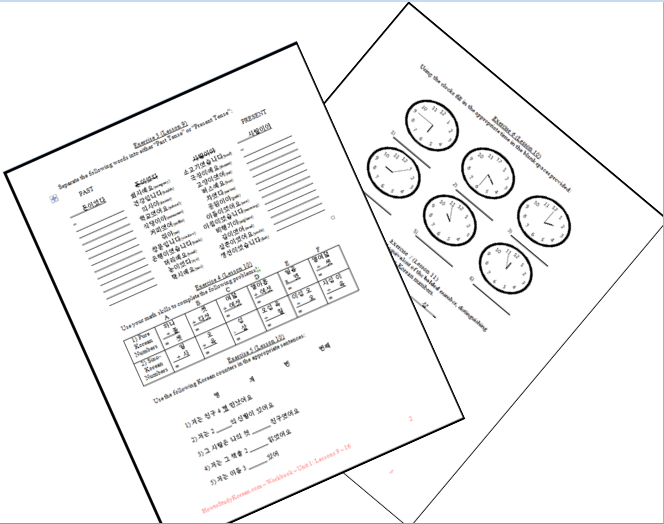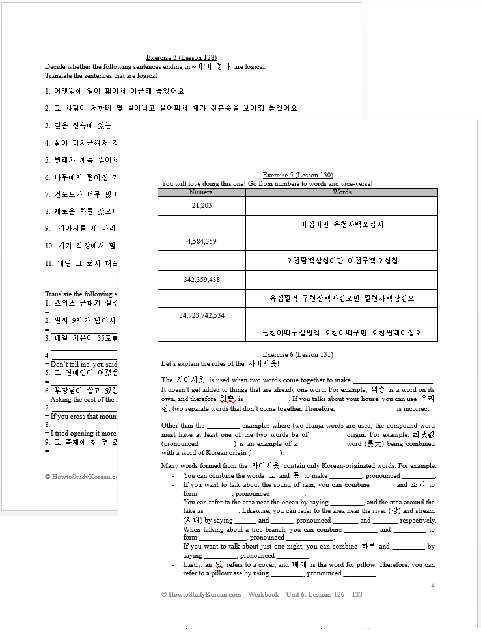New Years Sale! For two weeks only, get all of our content in a particular Unit for 40% off! Check it out!
You can purchase our content in “bulk” with our Basic, Dedicated and Elite packages. Doing so allows you to get our resources at a massive (more than to 50%) discount!
————
In addition to our lessons, we also offer supplemental Workbooks – where you can practice your Korean doing interesting and effective exercises relevant to what you learned in our Lessons. These workbooks are designed to be a supplement, to be used after reading individual lessons to help you practice and grasp what we teach. We have had a lot of feedback from our readers and they have all been asking us to add this to our list of things that we offer on this website.
Although all of our lessons on our website are free, we have decided that we want to sell these workbooks to our readers for $5 each. All of the Workbooks are PDF files that I personally e-mail to you.
If you live in Korea, you could also send us the funds directly. E-mail us at howtostudykorean@gmail.com for more information.
We currently offer Workbooks for Lessons in Unit 0, Unit 1, Unit 2, Unit 3, Unit 4, Unit 5 and Unit 6.
Unit 0: Lessons 1 – 3
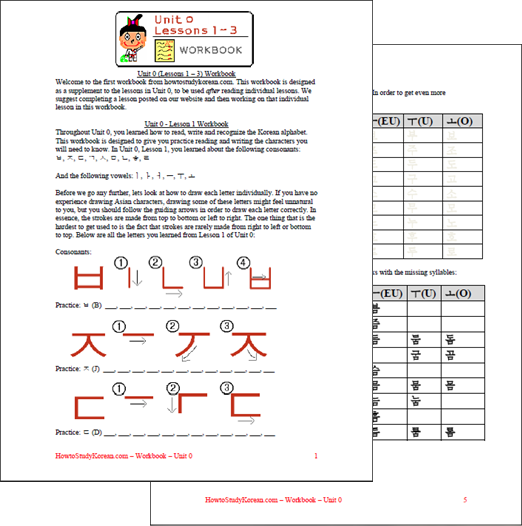
Use this Workbook to get all the practice you need in order to memorize all the letters in the Korean alphabet. Not only will you be able to memorize the alphabet, but you will also be able to properly read and write every letter after finishing this Workbook. In addition to this, you will be able to practice writing blocks of syllables and words using all the letters that you learned. Click the picture to the left to see an example of the first page of the Workbook (the full Workbook is 15 pages).
Unit 1
You can order a physical paperback copy of all Unit 1 Workbooks on Amazon.
Unit 1: Lessons 1 – 8
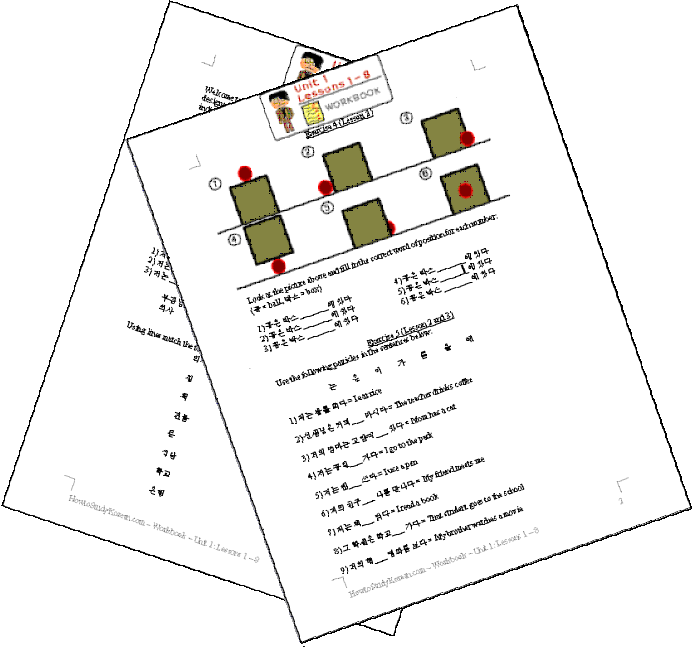 Use this Workbook to practice the basic Korean grammar you learned in the first eight lessons of Unit 1. Put your brain to the test by using the various words, particles and grammatical principles in a variety of different Korean grammar exercises. In addition to this, by using our exercises you will get practice reading, writing and understanding sentence structure and how to conjugate Korean verbs and adjectives correctly. There is also an answer key so you can check your answers to all of your completed exercises! Click the picture to the left to see an example of the first pages of the Workbook (the full Workbook is 20 pages).
Use this Workbook to practice the basic Korean grammar you learned in the first eight lessons of Unit 1. Put your brain to the test by using the various words, particles and grammatical principles in a variety of different Korean grammar exercises. In addition to this, by using our exercises you will get practice reading, writing and understanding sentence structure and how to conjugate Korean verbs and adjectives correctly. There is also an answer key so you can check your answers to all of your completed exercises! Click the picture to the left to see an example of the first pages of the Workbook (the full Workbook is 20 pages).
—–
Unit 1: Lessons 9 – 16
Use this Workbook to get real life practice using the concepts you learned in Lessons 9 -16 of Unit 1! Start out by getting tons of practice using 이다 in a variety of different exercises. You will then be able to practice reading, writing and recognizing numbers and descriptions of time using exercises in Korean that you can apply directly to real life! Following that, you can practice all of the confusing Korean particles and words you learned throughout Lessons 9-16. As with the previous Workbook, there is an answer key where you can check your answers on all of your completed exercises. Click the picture to the left to see an example of some of pages in the Workbook (the full Workbook is 16 pages)!
—–
Unit 1: Lessons 17 – 25
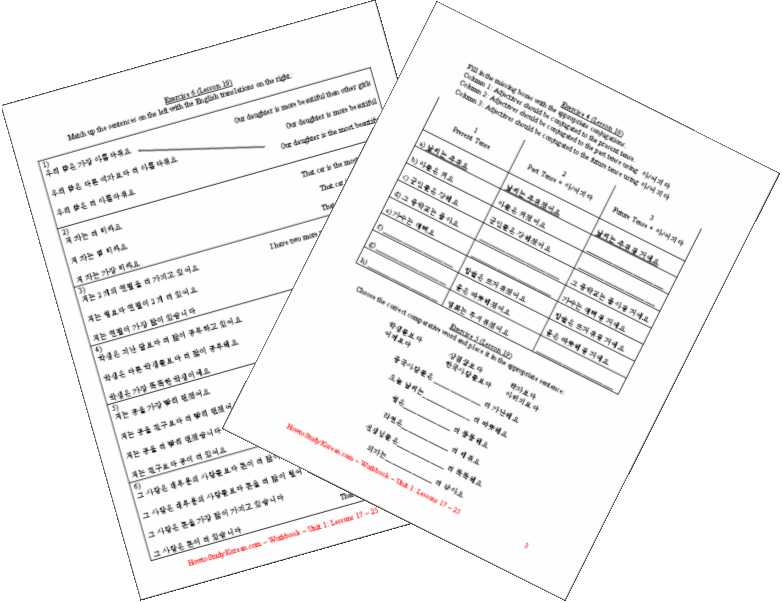 Use this Workbook to get tons of practice using the concepts you learned in Lessons 17 – 25. Start off by practicing the correct usage of various connecting and ending grammatical principles, including ~고, ~고 싶다, ~고 있다, and ~아/어지다. Following that, you will find a variety of exercises where you can practice comparative and superlative sentences (using 더, 보다, 가장), and the confusing usages of 잘, 잘하다, 못, 못하다, and ~지 못하다. You will then be able to practice making sentences using question words and practice making clauses using 전 and 후. Finally, you will practice using all the confusing “some—, every—, any—, no—” words!
Use this Workbook to get tons of practice using the concepts you learned in Lessons 17 – 25. Start off by practicing the correct usage of various connecting and ending grammatical principles, including ~고, ~고 싶다, ~고 있다, and ~아/어지다. Following that, you will find a variety of exercises where you can practice comparative and superlative sentences (using 더, 보다, 가장), and the confusing usages of 잘, 잘하다, 못, 못하다, and ~지 못하다. You will then be able to practice making sentences using question words and practice making clauses using 전 and 후. Finally, you will practice using all the confusing “some—, every—, any—, no—” words!
As with the previous Workbooks, there is an answer key where you can check your answers for all exercises. Click the picture to the left to see an example of some of pages in the Workbook (the full Workbook is 17 pages)!
Unit 2
Unit 2: Lessons 26 – 33
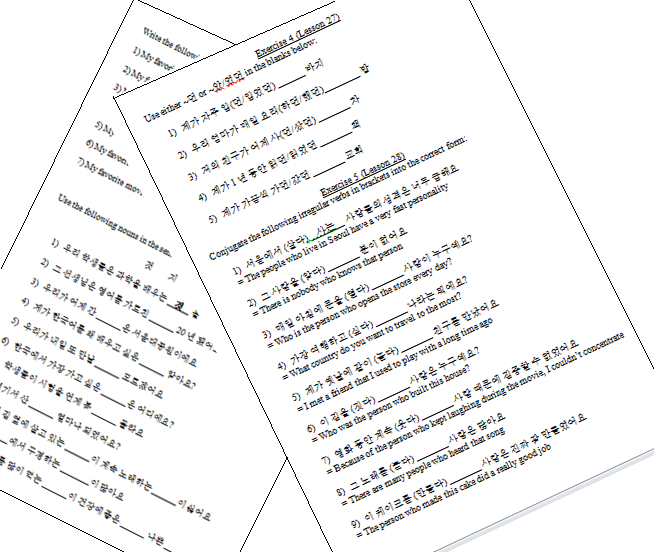 Here we go! With our first Workbook in Unit 2, you can practice everything that you learned in Lessons 26 to 33! Start off with a variety of exercises allowing you to better your understanding of the ~는 것 principle. Everything including simple ~는 것 sentences, using ~는 것 in the past and future tenses, ~는 것 irregulars, and the common nouns that often replace “것” (지, 중, 적, etc…). In addition, you will be able to practice making your own sentences using the principles discussed in these eight lessons.
Here we go! With our first Workbook in Unit 2, you can practice everything that you learned in Lessons 26 to 33! Start off with a variety of exercises allowing you to better your understanding of the ~는 것 principle. Everything including simple ~는 것 sentences, using ~는 것 in the past and future tenses, ~는 것 irregulars, and the common nouns that often replace “것” (지, 중, 적, etc…). In addition, you will be able to practice making your own sentences using the principles discussed in these eight lessons.
Of course, an answer key is provided. Click the picture to the left to see an example of some of the pages in the Workbook (the full Workbook is 13 pages).
—–
Unit 2: Lessons 34 – 41
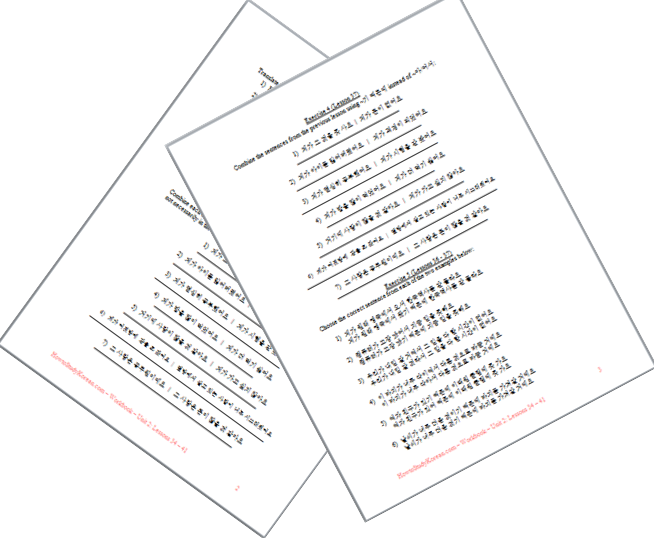 Now we are starting to get a little bit more difficult! In this Workbook, you will be able to practice all the concepts that you learned in Lessons 34 – 41. Start out by constructing sentences using the difficult words presented in Lesson 34 and using the ~ㄹ 것 같다 principle presented in Lesson 35. Following that, you will better understand how to say “because/therefore” in Korean by practicing the correct usage of ~아/어서 and ~기 때문에 in sentences. Finally, you will practice creating imperative sentences and using the honorific ~(으)시 ending.
Now we are starting to get a little bit more difficult! In this Workbook, you will be able to practice all the concepts that you learned in Lessons 34 – 41. Start out by constructing sentences using the difficult words presented in Lesson 34 and using the ~ㄹ 것 같다 principle presented in Lesson 35. Following that, you will better understand how to say “because/therefore” in Korean by practicing the correct usage of ~아/어서 and ~기 때문에 in sentences. Finally, you will practice creating imperative sentences and using the honorific ~(으)시 ending.
As with all Workbooks, an answer key is provided. Click the picture to the left to see an example of some of the pages in the Workbook (the full Workbook is 13 pages).
—–
Unit 2: Lessons 42 – 50
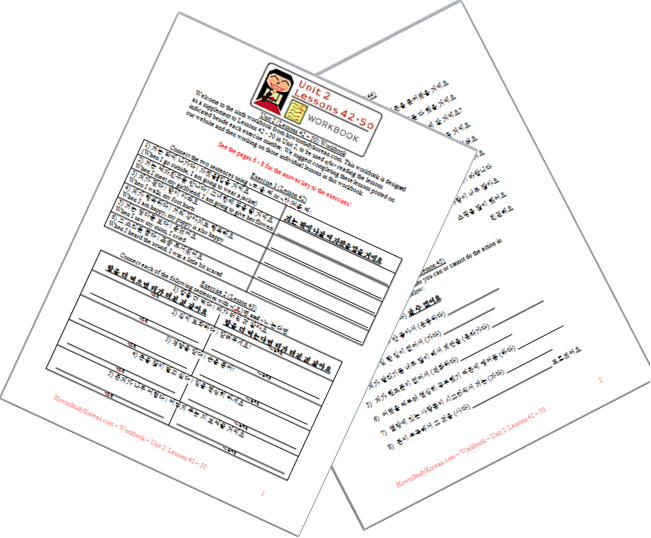 Now that you have reached these higher (more difficult) lessons, your understanding of Korean grammar should be very good. What you need now is practice using the variety of sentence-connecting and sentence-ending grammatical principles to make your sentences more complex. In this Workbook, you will be able to practice connecting two clauses by saying “if” and “when” using ~(으)면, ~ㄴ/는다면 and ~ㄹ/을 때. Following that, you will practice using the sentence-ending grammatical principles: ~ㄹ/을 수 있다/없다, ~아/어 야 하다, ~ㄹ/을 필요가 없다 and ~아/어도 되다. In addition, the final exercise allows you to practice all the concepts you learned up to this point.
Now that you have reached these higher (more difficult) lessons, your understanding of Korean grammar should be very good. What you need now is practice using the variety of sentence-connecting and sentence-ending grammatical principles to make your sentences more complex. In this Workbook, you will be able to practice connecting two clauses by saying “if” and “when” using ~(으)면, ~ㄴ/는다면 and ~ㄹ/을 때. Following that, you will practice using the sentence-ending grammatical principles: ~ㄹ/을 수 있다/없다, ~아/어 야 하다, ~ㄹ/을 필요가 없다 and ~아/어도 되다. In addition, the final exercise allows you to practice all the concepts you learned up to this point.
Again, an answer key is provided. Click the picture to the left to see an example of some of the pages in the Workbook (the full Workbook is 16 pages).
Unit 3
Unit 3: Lessons 51 – 58
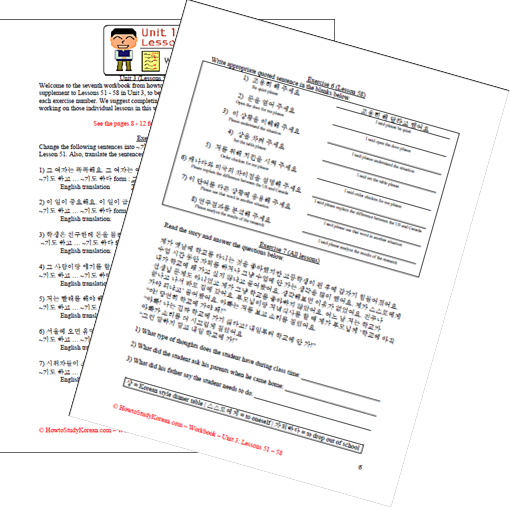 Now it’s time to really get serious. Get ready to practice all the grammatical principles you learned in Lessons 51 to 58. A lot of these lessons were centered on quoting in Korean – so you can be sure you will be getting lots of practice making proper quotes sentences in this Workbook. In addition to that, you will be able to practice how to use things like ~기도하고… ~기도하다, ~거나, ~(이)나 and ~게.
Now it’s time to really get serious. Get ready to practice all the grammatical principles you learned in Lessons 51 to 58. A lot of these lessons were centered on quoting in Korean – so you can be sure you will be getting lots of practice making proper quotes sentences in this Workbook. In addition to that, you will be able to practice how to use things like ~기도하고… ~기도하다, ~거나, ~(이)나 and ~게.
The Workbooks in Unit 3 also use sentences with more difficult vocabulary to allow you to be familiar with more complicated situations. Of course, all the answers are provided. (Workbook length: 15 pages)
—–
Unit 3: Lessons 59 – 66
I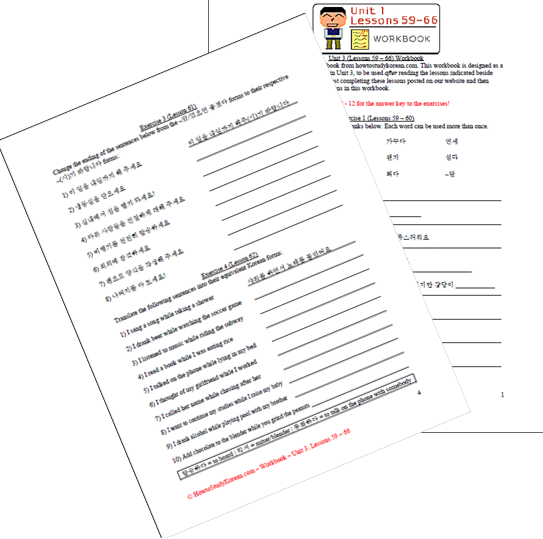 n this Workbook, you can get more practice using the grammatical principles you learned in Lessons 59 – 66. Not only will you be able to practice the difficult words you learned at the beginning of these eight lessons, but you will also get practice using ~았/었으면 좋겠다, ~기 바랍니다 and ~(으)면서. Of course, you will also get more practice distinguishing amongst the various usages of ~까(요).
n this Workbook, you can get more practice using the grammatical principles you learned in Lessons 59 – 66. Not only will you be able to practice the difficult words you learned at the beginning of these eight lessons, but you will also get practice using ~았/었으면 좋겠다, ~기 바랍니다 and ~(으)면서. Of course, you will also get more practice distinguishing amongst the various usages of ~까(요).
The Workbooks in Unit 3 also use sentences with more difficult vocabulary to allow you to be familiar with more complicated situations. Of course, all the answers are provided. (Workbook length: 12 pages)
—–
Unit 3: Lessons 67 – 75
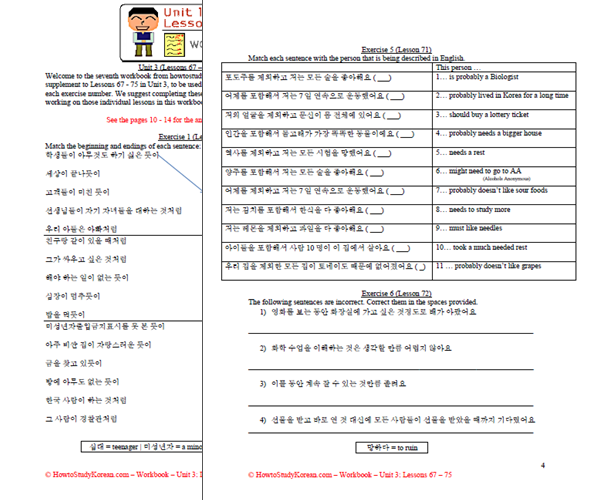 In this Workbook, you can apply the knowledge of the grammatical principles you learned in Lessons 67 – 75. Tons of grammatical principles in these lessons – all of which are important to master before you embark on Unit 4. Get practice using: ~듯, ~처럼, 유일하다, ~아/어, 제외하다, 포함하다, 만큼, 정도, 대신, 상관없다 and 신경 안 쓰다!
In this Workbook, you can apply the knowledge of the grammatical principles you learned in Lessons 67 – 75. Tons of grammatical principles in these lessons – all of which are important to master before you embark on Unit 4. Get practice using: ~듯, ~처럼, 유일하다, ~아/어, 제외하다, 포함하다, 만큼, 정도, 대신, 상관없다 and 신경 안 쓰다!
The Workbooks in Unit 3 also use sentences with more difficult vocabulary to allow you to be familiar with more complicated situations. Of course, all the answers are provided. (Workbook length: 14 pages)
Unit 4
Unit 4: Lessons 76 – 83
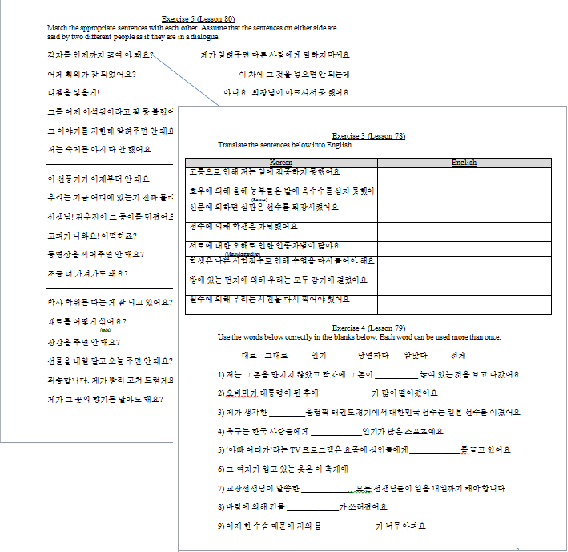 You thought Unit 3 was hard? Get ready to practice the difficult (and natural!) grammar that you learned in Lessons 76 to 83. Of course, you will get practice using ~는데, because Lessons 76 and 77 were dedicated to that. Following that, you will practice using ~에 의해 and ~(으)로 인해, and the difficult words you learned in Lesson 79. In addition, you will be able to practice using things like 되다, ~아/어서는 안 되다, ~(으)면 안 되다, ~(으)니, ~(으)니까, ~구나, ~군, ~군요 and ~네(요).
You thought Unit 3 was hard? Get ready to practice the difficult (and natural!) grammar that you learned in Lessons 76 to 83. Of course, you will get practice using ~는데, because Lessons 76 and 77 were dedicated to that. Following that, you will practice using ~에 의해 and ~(으)로 인해, and the difficult words you learned in Lesson 79. In addition, you will be able to practice using things like 되다, ~아/어서는 안 되다, ~(으)면 안 되다, ~(으)니, ~(으)니까, ~구나, ~군, ~군요 and ~네(요).
As with Unit 3 , the exercises in Unit 4 use sentences with difficult vocabulary and grammar to allow you to become familiar with more complicated situations. Answers and English translations are provided for every problem. (Workbook length: 14 pages)
—–
Unit 4: Lessons 84 – 91
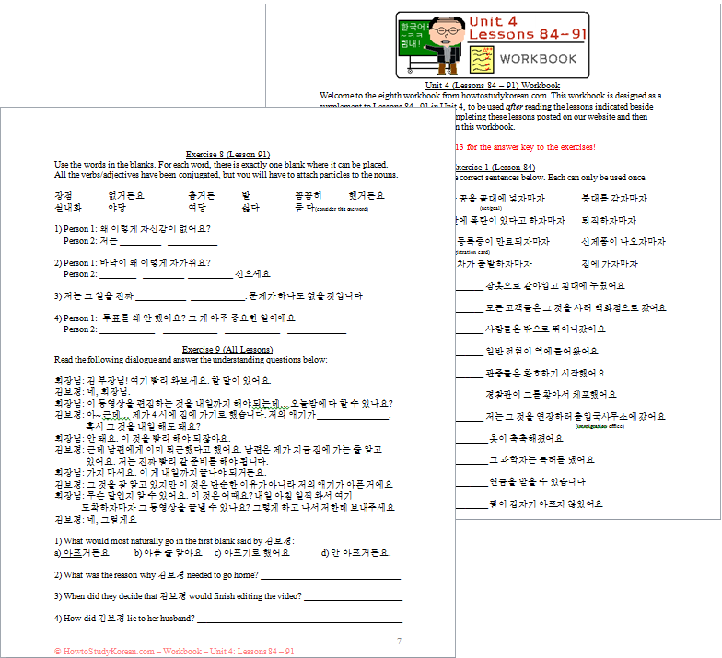 In this Workbook, you can get more practice using the grammatical principles you learned in Lessons 84 – 91. You will be able to practice using ~자마자, 줄 알다/모르다, 아니라, ~기로 하다, fractions, ~잖다 and the many meanings of ~다가 and ~거든.
In this Workbook, you can get more practice using the grammatical principles you learned in Lessons 84 – 91. You will be able to practice using ~자마자, 줄 알다/모르다, 아니라, ~기로 하다, fractions, ~잖다 and the many meanings of ~다가 and ~거든.
The Workbooks in Unit 4 use sentences with more difficult vocabulary and grammar to allow you to be familiar with more complicated situations. Answers and English translations are provided for every problem. (Workbook length: 13 pages)
—–
Unit 4: Lessons 92 – 100
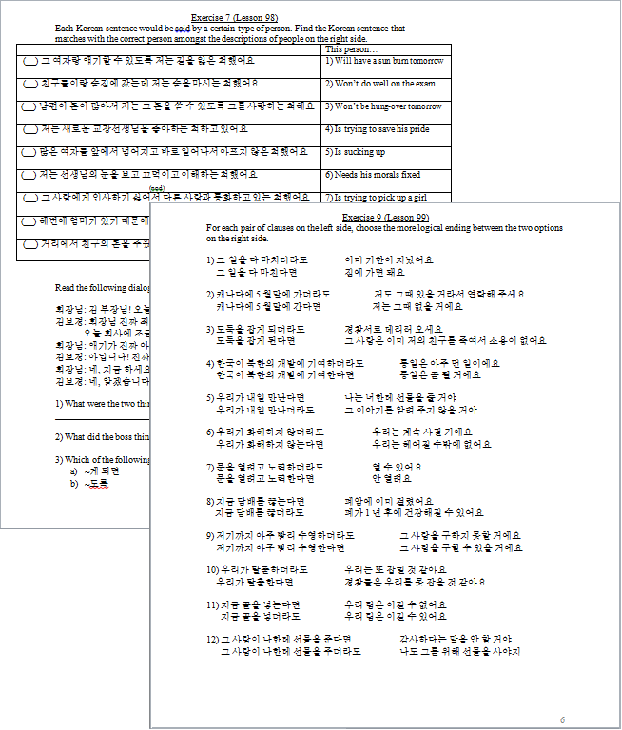 In this Workbook, you can apply the knowledge of the grammatical principles you learned in Lessons 92 – 100. Lots of stuff in these lessons – all of which are important to understand before you start with Unit 5. Get practice using: ~도록, ~지/죠, ~게 되다, 뿐, 뿐만 아니라, ~(으)려면, ~는 척하다, and the many meanings of 텐데.
In this Workbook, you can apply the knowledge of the grammatical principles you learned in Lessons 92 – 100. Lots of stuff in these lessons – all of which are important to understand before you start with Unit 5. Get practice using: ~도록, ~지/죠, ~게 되다, 뿐, 뿐만 아니라, ~(으)려면, ~는 척하다, and the many meanings of 텐데.
The Workbooks in Unit 4 use sentences with more difficult vocabulary and grammar to allow you to be familiar with more complicated situations. Answers and English translations are provided for every problem. (Workbook length: 15 pages)
Unit 5
Lessons 101 – 108
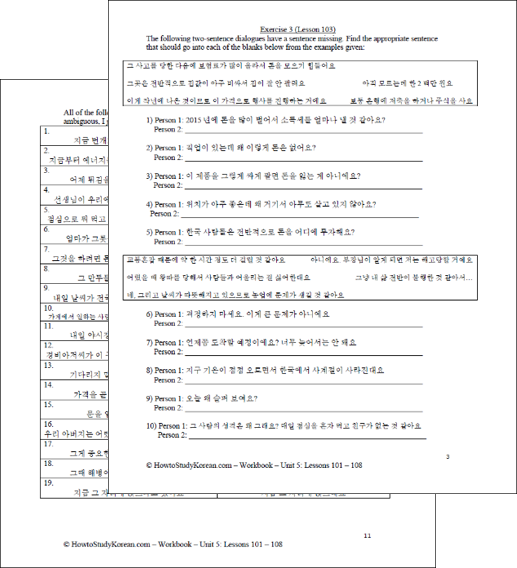 Get a jump on the materials introduced in Unit 5. We introduce some fundamental, confusing twists on concepts that you learned all the way back in Unit 1. Get practice with Korean internet slang, quoted abbreviations (~는대, ~았/었대, etc…), ~는/은, ~든지, ~도, 았/었었다, and the many other smaller principles like ~약, 한, ~(으)므로, 전반, ~당하다, ~아/어뜨리다, 화 and ~께서.
Get a jump on the materials introduced in Unit 5. We introduce some fundamental, confusing twists on concepts that you learned all the way back in Unit 1. Get practice with Korean internet slang, quoted abbreviations (~는대, ~았/었대, etc…), ~는/은, ~든지, ~도, 았/었었다, and the many other smaller principles like ~약, 한, ~(으)므로, 전반, ~당하다, ~아/어뜨리다, 화 and ~께서.
Of course, all of exercises have solutions (with translations to English). (Workbook length: 16 pages)
—–
Lessons 109 – 116
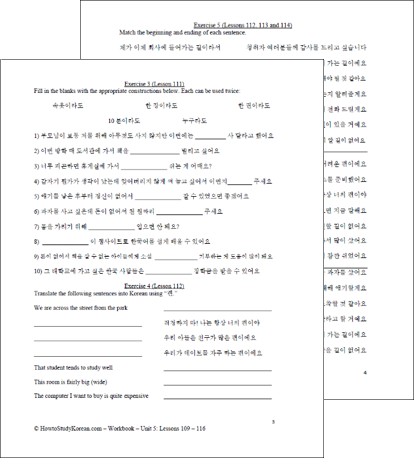 Build on the concepts that really add to your fluency. Things like ~나 보다, 어쩔 수 없다, ~(이)라도 and ~ㄹ/을걸 그렇다 are difficult, semi-uncommon concepts that make your speech sound very natural. In addition, get practice with concepts that utilize the ~는 것 principle like ~는 편, ~는 길, ~는 김, and ~ㄴ/은 채.
Build on the concepts that really add to your fluency. Things like ~나 보다, 어쩔 수 없다, ~(이)라도 and ~ㄹ/을걸 그렇다 are difficult, semi-uncommon concepts that make your speech sound very natural. In addition, get practice with concepts that utilize the ~는 것 principle like ~는 편, ~는 길, ~는 김, and ~ㄴ/은 채.
English translations – yes! Answers – yes! (Workbook length: 12 pages)
—–
Lessons 117 – 125
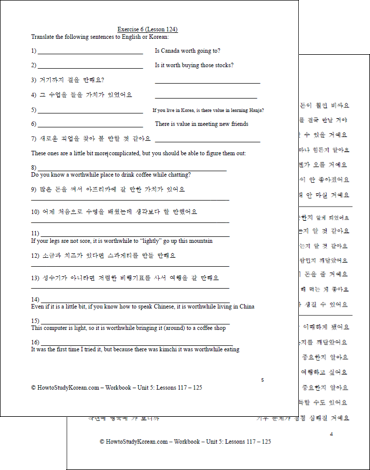 Woah, this was a tough one. Tons of grammatical principles that have ~다 or ~더 added to the stem of a word. Get practice with ~던가, ~더라, ~더니, ~다니, ~다 보면, ~다 보니까, ~아/어 보니까, and ~다니까. In addition, practice the use of ~ㄹ/을 만하다 and 가치 from Lesson 124.
Woah, this was a tough one. Tons of grammatical principles that have ~다 or ~더 added to the stem of a word. Get practice with ~던가, ~더라, ~더니, ~다니, ~다 보면, ~다 보니까, ~아/어 보니까, and ~다니까. In addition, practice the use of ~ㄹ/을 만하다 and 가치 from Lesson 124.
English translations – you know it! Answers – of course! (Workbook length: 12 pages)
Unit 6
Lessons 126 – 133
Here we go with our first Workbook in Unit 6. Here you will get practice with 별(로), ~씩, ~아/어 놓다 and 넘다, big Korean numbers, ~ㄹ/을 리가 없다, ~ㄹ/을 수록 and everybody’s favorite thing – the 사이시옷!
—–
Lessons 134 – 141
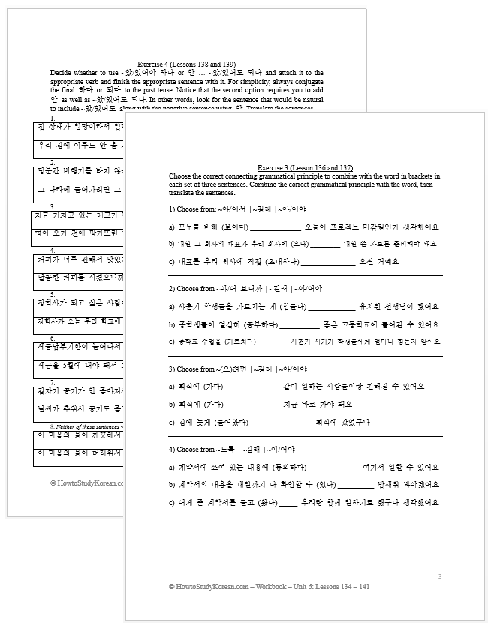 This Workbook starts off with exercises that allow you to practice Konglish words and words with 성. Then, you will find exercises that will allow you to practice distinguishing between the similar grammatical principles ~길래 and ~아/어야; ~았/었어야 하다 and ~았/었어도 되다; and ~(으)로서 and ~(으)로써!
This Workbook starts off with exercises that allow you to practice Konglish words and words with 성. Then, you will find exercises that will allow you to practice distinguishing between the similar grammatical principles ~길래 and ~아/어야; ~았/었어야 하다 and ~았/었어도 되다; and ~(으)로서 and ~(으)로써!
—–
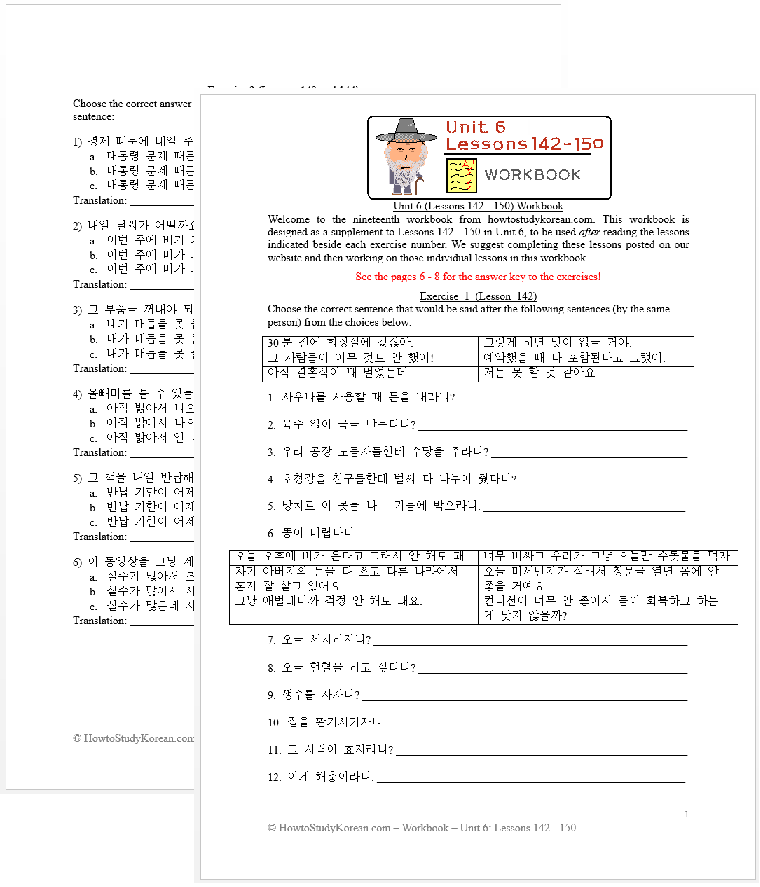 Our final Workbook in Unit 6. Practice concepts that are taught in Lessons 142 – 150: ~다니, ~자니, ~라니, ~ㄹ/을걸(요), ~지 뭐(요), ~란, ~느라고, ~는 바람에, ~곤 하다, 어쩐지 and 하필!
Our final Workbook in Unit 6. Practice concepts that are taught in Lessons 142 – 150: ~다니, ~자니, ~라니, ~ㄹ/을걸(요), ~지 뭐(요), ~란, ~느라고, ~는 바람에, ~곤 하다, 어쩐지 and 하필!
Unit 7
 Our first Workbook in Unit 7! Practice all of the concepts taught in Lessons 151 – 158: 의성어, 의태어, all of the versions of ~(으)려~ that are introduced, 경우 and 위주!
Our first Workbook in Unit 7! Practice all of the concepts taught in Lessons 151 – 158: 의성어, 의태어, all of the versions of ~(으)려~ that are introduced, 경우 and 위주!
—
Workbooks for later lessons will be uploaded as they come out! If you ever have any questions, don’t hesitate to contact me.


